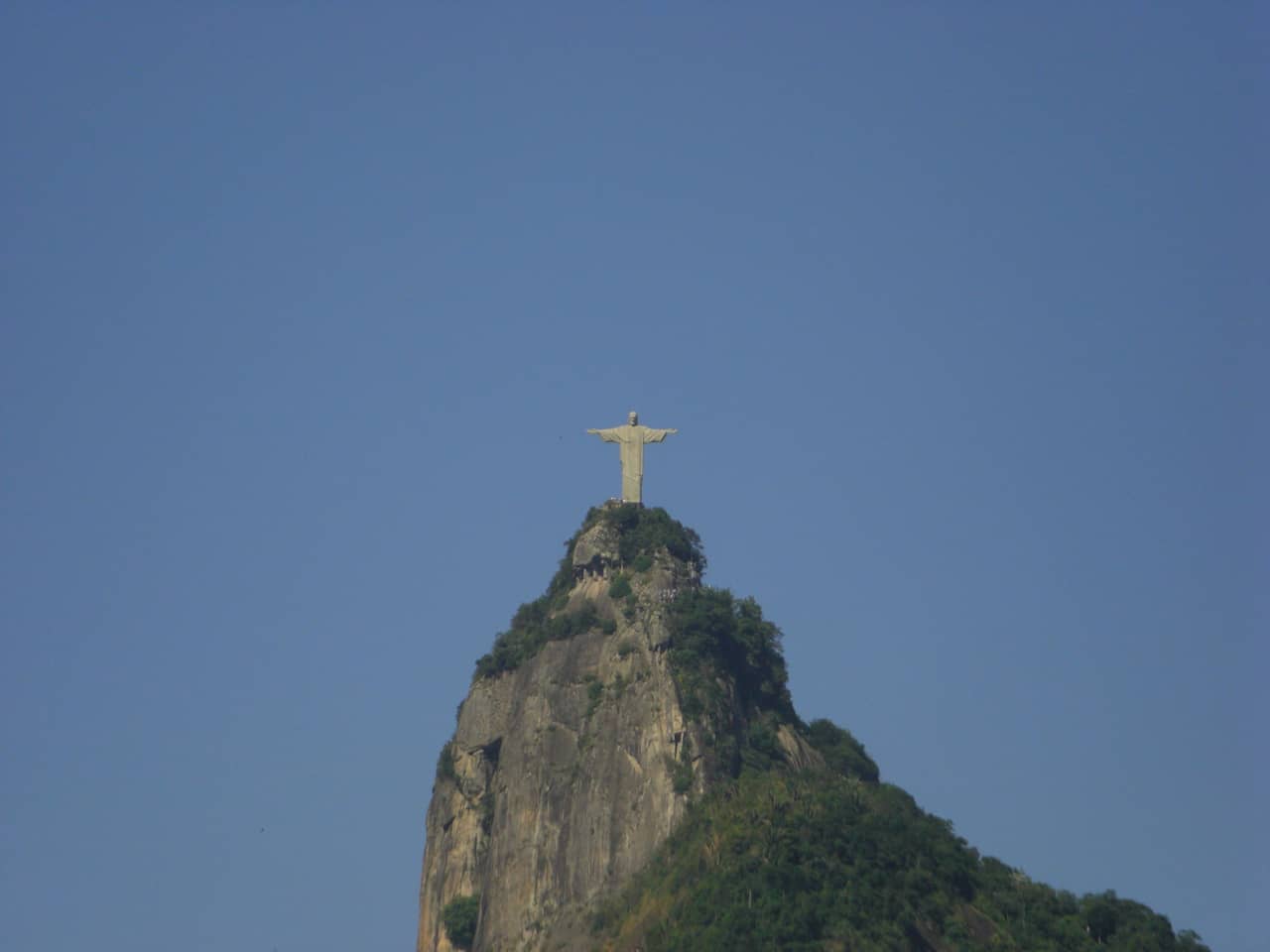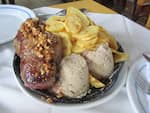Rio de Janeiro is certainly the best-known tourist destination in Brazil.
However, most come with the image of the beaches of Ipanema and Copacabana, Christ the Redeemer, samba and lots of sun.
However, Rio de Janeiro is much more than that, being a fascinating mix of natural beauty, vibrant culture and a relaxed lifestyle.
The city is known as the “Marvelous City” due to its concentration of stunning landscapes such as Christ the Redeemer, Pedra da Gávea, Sugar Loaf, offering unparalleled panoramic views of the city and of course its beaches.
The beating heart of the city is the bohemian neighborhood of Santa Teresa, with its cobblestone streets, vibrant street art and artistic atmosphere. Santa Teresa’s winding hills and colorful cable cars offer a unique experience, while local bars and restaurants provide a taste of Rio’s delicious cuisine.
Plus, Rio’s musical culture is legendary, with samba flowing through the streets.
A visit to historic neighborhoods like Lapa, with its illuminated arches and vibrant nightlife, is a must for music and dance lovers.
We cannot forget the rich history and cultural heritage, from the Catete Palace, the former seat of the Brazilian government, to the Rio Art Museum (MAR), which combines contemporary art and historical exhibitions.
For nature lovers, there is the option of trails in the middle of the Atlantic Forest that lead to hidden waterfalls and stunning viewpoints. The Botanical Garden offers a peaceful retreat, while Parque Lage, at the foot of Corcovado, is a popular spot for picnics and walks.
And of course, we cannot forget the “Carioca” way of being that captivates everyone.
A little history of Rio de Janeiro:
Rio de Janeiro has a rich and fascinating history that dates back to pre-Columbian times, when it was inhabited by Tupinambá and Tupiniquin indigenous peoples. However, its most recognizable history begins with the arrival of Portuguese explorers in 1502, led by Gonçalo Coelho and Américo Vespúcio, who sailed through the bay and named the place “Rio de Janeiro” (Rio Janeiro) due to its appearance believed to be the mouth of a large river (which, in fact, was the entrance to the bay).
In the 16th century, the Portuguese established what is now the historic center of Rio de Janeiro, founding the city of São Sebastião do Rio de Janeiro in 1565. During the colonial period, the city prospered as an important commercial center due to the sugar trade , gold and African slaves.
In 1808, Rio de Janeiro became the seat of the Portuguese Empire after the Portuguese royal family fled Napoleonic invasions and settled in Brazil. This change brought a series of significant developments to the city, including the opening of ports to international trade and the modernization of urban infrastructure.
After Brazil’s independence in 1822, Rio de Janeiro became the capital of the new country. During the 19th century, the city underwent rapid growth and development, marked by the construction of large buildings, parks and avenues, such as the Imperial Palace, Avenida Rio Branco and Praça Mauá.
In 1960, Brazil’s capital was transferred to Brasília, but Rio de Janeiro continued to be an important cultural, economic and tourist center in the country.
Main attractions in Rio de Janeiro.
1. Christ the Redeemer.
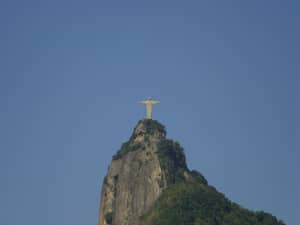
Christ the Redeemer is one of the most recognized images in Brazil, as well as being one of the 7 wonders of the modern world.
It is located at the top of Morro do Corcovado, about 710 meters above sea level, in the Tijuca National Park, this majestic statue of Jesus Christ with open arms overlooking the city of Rio de Janeiro.
Built between 1922 and 1931, Christ the Redeemer was a monumental work of engineering and art. With its 30 meters in height, in addition to an additional 8 meters of pedestal, the statue has become a symbol of faith and welcome for the locals and the entire world.
In addition to its spiritual and religious importance, Christ the Redeemer provides a 360-degree panoramic view of the city of Rio de Janeiro, including the beaches, mountains, forests and Guanabara Bay.
Every day, thousands of tourists from all over the world visit Christ the Redeemer, whether for its religious importance, its impressive panoramic view or simply to witness the magnitude of this masterpiece of art and engineering. For many, a visit to Rio de Janeiro is not complete without stopping to contemplate this monumental wonder that symbolizes the city and its people.
2. Tijuca National Park.
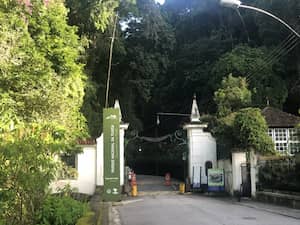
Tijuca National Park is one of the largest areas of urban forest in the world, located in the heart of Rio de Janeiro, housing a rich variety of flora and fauna amid the city’s urban landscape.
The park was created in 1961, to preserve the Atlantic Forest, one of the most threatened biomes in Brazil.
Among the park’s most popular attractions are the trail to Pedra da Gávea, one of the largest rock formations in the world overlooking the Atlantic Ocean, and the trail to Cascatinha Taunay, a beautiful waterfall hidden in the forest.
Another highlight of Tijuca National Park is Corcovado, where the iconic statue of Christ the Redeemer is located. The climb to the top of Corcovado offers spectacular views of the city of Rio de Janeiro and is an unforgettable experience for visitors.
3. Botanical garden.
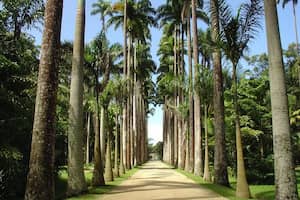
Another large green area is the Botanical Garden, founded in 1808 by D. João VI, it was initially designed for the cultivation of exotic plants brought from other parts of the world, but over the years it has become an important center for research, conservation and environmental education.
Located in the Jardim Botânico neighborhood, close to Parque Lage and Corcovado, the Jardim Botânico covers an area of over 140 hectares, where visitors can enjoy a dazzling array of tropical and subtropical plants.
One of the main attractions of the Botanical Garden is its collection of exotic plants, including imperial palms, orchids, bromeliads and centuries-old trees. Also notable is the carnivorous plant greenhouse, where visitors can learn about these fascinating plants that feed on insects.
In addition to the exuberant flora, the Botanical Garden also offers a series of additional attractions, such as hiking trails, lakes with water lily pads, themed gardens and leisure areas for picnics. The Environment Museum, located within the garden, features educational exhibits on nature conservation and biodiversity.
4. Lapa neighborhood.
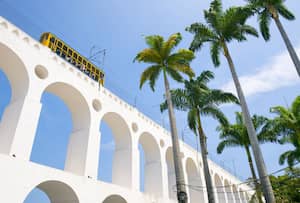
The Lapa neighborhood is known for its cultural life, historic architecture and lively nightlife scene. Located in the city center, Lapa is one of the most vibrant and eclectic neighborhoods in Rio.
One of the main characteristics of Lapa is its historic architectural complex, with emphasis on the Carioca Aqueduct, also known as Arcos da Lapa, an impressive colonial-style structure that dates back to the 18th century.
In addition to the arches, Lapa is famous for its bars, restaurants, concert halls and nightclubs, which offer a variety of entertainment options for all tastes. At night, the neighborhood transforms into a meeting point for music and dance lovers, with samba, electronic music, rock and other musical styles pulsing through the streets.
Nearby is the Escadaria Selarón, a colorful and unique work of art created by Chilean artist Jorge Selarón that has become a popular tourist attraction.
During the day, Lapa is also a cultural center, with art galleries, theaters and cultural centers that promote exhibitions, plays, shows and other artistic activities.
5. Ipanema Beach.
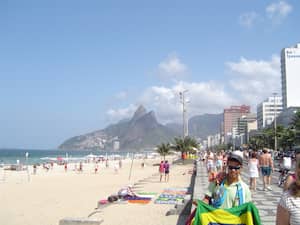
Ipanema Beach is one of the most famous beaches in Rio de Janeiro, known internationally for its stunning beauty, lively atmosphere and relaxed lifestyle.
The beach was immortalized in Tom Jobim’s song “Garota de Ipanema” with lyrics by Vinícius de Moraes.
Located in the South Zone of the city, between the neighborhoods of Ipanema and Leblon, this beach is one of the most popular destinations for those looking to enjoy the sun, sea and fine sand of Rio de Janeiro.
The Ipanema boardwalk, known as “Calçadão Visconde de Pirajá”, is a point where visitors can go walking, running, cycling or simply relax and enjoy the stunning scenery of the beach.
Along the shore, kiosks and beach huts offer a variety of local snacks, refreshing drinks and delicious Brazilian cuisine, such as the classic “globe cookie” and the traditional caipirinha.
In addition to its stunning beaches, Ipanema also offers a variety of shops, restaurants, bars and cafes along the neighborhood’s tree-lined streets.
6. Selarón Staircase.
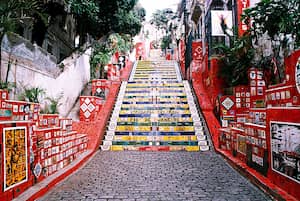
Escadaria Selarón, located in the Lapa neighborhood, is a work of public art created by Chilean artist Jorge Selarón, who dedicated much of his life to transforming the staircase into an outdoor art gallery.
Selarón’s work began in 1990, when he decided to revitalize the staircase in front of his house. He began covering the steps with colorful tiles, creating patterns and images that reflected his artistic vision and life experiences. Over the years, Selarón worked tirelessly on the staircase, using tiles from around the world, including donations from travelers and admirers of his work.
The staircase, which initially had just 215 steps, ended up extending for more than 200 meters and featuring more than 2,000 tiles of different colors, shapes and styles. The result is a unique and impressive work of art that attracts thousands of visitors every year.
In addition to the tiles, the Selarón Escadaria also features sculptures, murals and other pieces of art created by Selarón himself, including a tribute to the countries he visited throughout his life.
7. Sugarloaf.
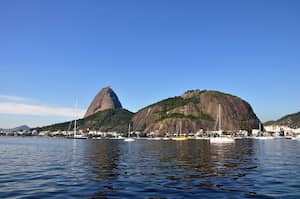
Sugarloaf Mountain is one of the most recognized tourist attractions in Rio de Janeiro, located at the entrance to Guanabara Bay, Sugarloaf Mountain is an imposing rock formation that rises 396 meters above sea level.
This mountain is made of granite and its steep slopes offer spectacular views of the city, beaches, ocean and surrounding countryside.
The climb to the top of Sugarloaf Mountain is done via a cable car that leaves from Praia Vermelha, offering a unique panoramic experience as you climb the hills.
It is made up of two main mountains, Sugarloaf Mountain itself and Morro da Urca, which is accessed during the first part of the journey by cable car. At Morro da Urca, visitors can enjoy panoramic views, restaurants, souvenir shops and even go on short trails.
Sugarloaf Mountain was one of the filming locations for the film “Moonraker” in 1979, where a famous James Bond scene was filmed on the cable car.
8. Gavea stone.
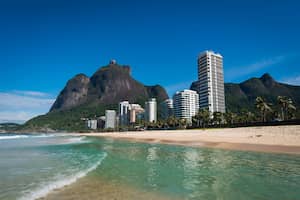
Gavea stone is an impressive rock formation located in the West Zone of Rio de Janeiro, in the São Conrado neighborhood. At approximately 842 meters high, it is one of the highest mountains in the world that rises directly from the Atlantic Ocean. Its distinctive and imposing silhouette makes it one of the most recognizable features of Rio’s skyline.
Gavea stone is also famous for its challenging trails and incredible panoramic views. The trail that leads to the top of the mountain is considered one of the most difficult in Rio de Janeiro, requiring climbing skills and hiking experience.
In addition to trails, the region around Pedra da Gávea offers a variety of outdoor activities, such as hang gliding, rock climbing and rappelling. São Conrado beach, at the foot of the mountain, is also a popular spot for water sports such as surfing and kitesurfing.
9. Telegraph stone.
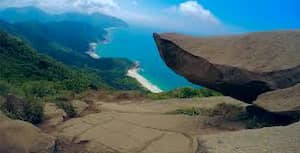
Telegraph Stone is a rock formation located in the West Zone of Rio de Janeiro, specifically in the neighborhood of Barra de Guaratiba. It has gained enormous popularity in recent years due to an optical illusion that creates the impression that people posing for photos are dangling from a cliff, with an abyss apparent just below them, when in fact the terrain is safe and relatively flat.
The trail to reach Telegraph Stone is considered an easy to moderate level and offers stunning views of Rio de Janeiro’s coastal landscape along the way. The walk takes about an hour and a half to two hours, depending on each person’s pace and physical condition.
Reaching the top, visitors are rewarded with spectacular views of Grumari beach, Restinga da Marambaia and the Atlantic Ocean. Additionally, the famous optical illusion provides unique opportunities for creative and memorable photos.
Telegraph Stone also has an interesting history. Its name comes from an old telegraph installed there in the 19th century to communicate between Rio de Janeiro and Angra dos Reis. Today, the rock is best known for its natural beauty and for being a popular tourist spot for locals and visitors who want to enjoy the incredible views and capture unique photos.
10. Copacabana Beach.
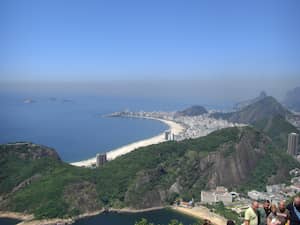
We cannot talk about Rio de Janeiro without mentioning Copacabana beach, which is more than just a beach; It is a sensory experience that captivates the senses and delights visitors from the moment their feet touch the golden sand.
With its 4.5 kilometers of soft sand and turquoise waters, Copacabana is a natural playground that attracts locals and tourists from around the world. The scenery is dominated by the famous Portuguese stone promenade in undulating patterns, which meander along the shore and invite you to relaxing walks by the sea.
During the day, Copacabana pulses with energy, with sunbathers enjoying the radiant sun and refreshing waves of the Atlantic Ocean. The beach is a vibrant mosaic of activity, with street vendors offering everything from local snacks to colorful crafts, and groups of friends playing beach soccer or racquetball.
As the sun sets over the horizon, Copacabana transforms into a stunning backdrop, with the sky tinged with warm shades of orange and pink. At night, the promenade comes to life with a riot of lights and sounds, while the beachfront bars, restaurants and kiosks offer a tempting array of gastronomic delicacies and refreshing cocktails.
In addition to its stunning natural beauty, Copacabana is a symbol of Rio de Janeiro’s culture and diversity. Its patrons are an eclectic mix of people of all ages, backgrounds and walks of life, creating a unique and inclusive atmosphere that celebrates the richness of the human experience.
11. Santa Teresa neighborhood.
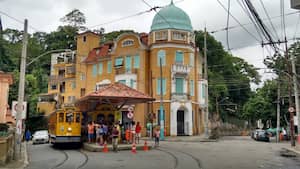
Santa Teresa, a picturesque neighborhood in Rio de Janeiro, with its bohemian atmosphere, cobblestone streets and colonial architecture.
It is nestled in Rio de Janeiro’s verdant hillsides, is a charming retreat that transports visitors back to the city’s golden era. Narrow, winding streets wind between meticulously preserved colonial mansions, creating a setting that seems straight out of a tropical fairy tale.
The beating heart of Santa Teresa is Rua Almirante Alexandrino, where bars, restaurants and eclectic art galleries mix in harmony.
One of Santa Teresa’s most distinctive features is the historic tram, which winds through the neighborhood’s narrow streets, providing passengers with stunning views of the city below. The tram is a vivid reminder of Santa Teresa’s glorious past, and is a charming way to explore its picturesque streets.
In addition to its aesthetic beauty, Santa Teresa is a cultural icon of Rio de Janeiro, home to artists, musicians and intellectuals who find inspiration in the neighborhood’s lush landscapes and vibrant atmosphere. Visitors are invited to explore local art galleries, participate in cultural events, and immerse themselves in Santa Teresa’s rich art scene.
At night, Santa Teresa takes on a new life, with bars and restaurants. It’s the perfect time to sip a cold caipirinha, listen to live music and get lost in the charming streets of this neighborhood.
12 Barra da Tijuca.
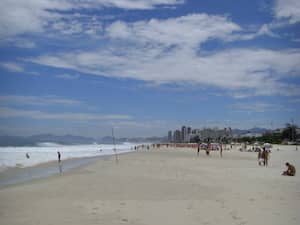
Barra da Tijuca, a coastal jewel of Rio de Janeiro, is a fusion of modernity and stunning nature that enchants with a unique mix of pristine beaches, lush landscapes and world-class urban infrastructure.
Praia da Barra, with its gentle waves and relaxing atmosphere, is a haven for sun and sea lovers, while Praia da Reserva offers a more tranquil setting, surrounded by the unspoilt beauty of the adjacent nature reserve.
In addition to its stunning beaches, Barra da Tijuca is famous for its modern and dynamic urban landscape. Imposing skyscrapers rise along the waterfront, forming an impressive skyline that rivals that of major metropolises around the world. This area is the epicenter of a vibrant nightlife, with a multitude of bars, restaurants and nightclubs offering world-class entertainment late into the night.
Whether relaxing on its stunning beaches, exploring its vibrant urban scene or connecting with nature in its lush green spaces, Barra da Tijuca is a true paradise for visitors to the Marvelous City.
13 Grumari Beach.
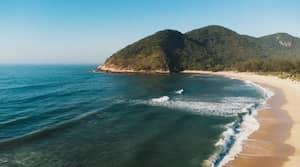
Grumari Beach is a natural paradise with its wild beauty and serene atmosphere. Located in the west of the city, Grumari offers a truly unique beach experience, far from the hustle and bustle of the more famous beaches.
With its stretch of golden sand and crystal clear waters, Grumari is a refuge for lovers of nature and tranquility. Surrounded by mountains covered in lush vegetation, the beach offers a stunning setting that seems untouched by time and civilization.
Unlike other urban beaches in Rio, Grumari maintains its natural and wild environment, with little commercial infrastructure and few buildings along the coast. This creates an atmosphere of peace and serenity where visitors can reconnect with nature and enjoy peaceful moments by the sea.
In addition to its inviting waters and stunning landscapes, Grumari is also home to a rich variety of marine life, making it a popular spot for diving and snorkeling. The offshore coral reefs are home to a wide diversity of colorful marine species, providing visitors with an unforgettable underwater exploration experience.
14 Tax island.
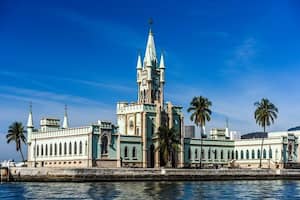
Ilha Fiscal, a historical and cultural icon of Rio de Janeiro, is an architectural jewel set against the stunning backdrop of Guanabara Bay. This small island, with its impressive neo-Gothic palace, evokes an era of elegance and grandeur.
The Ilha Fiscal Palace, with its imposing architecture and pointed towers, is the island’s undisputed highlight. Built at the end of the 19th century, the palace is a testament to the refinement and opulence of the time, with its sumptuously decorated halls, colorful stained glass windows and stunning views of the bay.
In addition to the palace, Ilha Fiscal also offers a stunning view of Guanabara Bay and Rio de Janeiro’s iconic tourist attractions, such as Sugarloaf Mountain and Christ the Redeemer. The well-kept gardens and panoramic terraces provide the perfect setting to admire the city’s natural beauty and capture memorable photos.
15 Museum of Modern art.
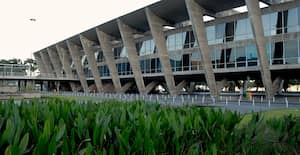
The Rio de Janeiro Museum of Modern Art (MAM) is an architectural and cultural masterpiece that enriches the artistic scene of the wonderful city. Situated in a privileged location, between the lush greenery of Parque do Flamengo and the sparkling waters of Guanabara Bay, MAM is an oasis of creativity and inspiration.
The museum’s modernist building, designed by renowned architect Affonso Eduardo Reidy, is an expression of simplicity and elegance. Its clean lines and geometric shapes create a perfect backdrop for displaying contemporary and modern works of art.
Inside the museum, visitors are greeted by an eclectic collection of artworks that span a variety of styles, techniques, and media. From vibrant paintings to provocative sculptures, immersive installations to moving performances, MAM offers a rich and diverse artistic experience that captivates the senses and stimulates the mind.
In addition to permanent and temporary exhibitions, MAM also hosts a series of cultural events, such as lectures, workshops and live performances, which further enrich visitors’ experience and promote dialogue between artists and the public.
Whether strolling the museum’s gardens, enjoying panoramic views of the bay or participating in one of the many cultural activities on offer, MAM visitors are invited to connect with art and the world around them in a unique and meaningful way.
16 Visit the Museum of Tomorrow.
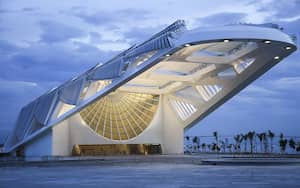
The Museum of Tomorrow, an architectural and intellectual jewel of Rio de Janeiro, is a vivid expression of the human quest to understand and question the future. Located in the city’s revitalized port area, this cultural icon challenges the traditional boundaries of museums, inviting visitors to explore the challenges and possibilities of tomorrow.
The futuristic Museum of Tomorrow building, designed by renowned Spanish architect Santiago Calatrava, is a masterpiece of innovative design. Its bold organic and geometric shapes evoke the image of a spaceship, while its sustainable materials and eco-friendly technologies reflect the museum’s commitment to preserving the environment.
Inside the museum, visitors are transported on a fascinating journey through time and space, exploring pressing questions about the future of humanity and planet Earth. Through interactive exhibitions, multimedia installations and immersive experiences, the Museum of Tomorrow invites visitors to reflect on topics such as sustainability, climate change, technological innovation and cultural diversity.
With a diverse program of lectures, debates, workshops and cultural events, the museum serves as a meeting point for people of all ages and backgrounds who share a common interest in the destiny of humanity.
17 Metropolitan Cathedral of Rio de Janeiro
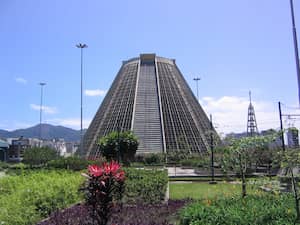
The Metropolitan Cathedral is an imposing architectural work that dominates the city’s skyline with its unique and grandiose shape. Located in the heart of the historic center, this modern cathedral is a symbol of faith and spirituality that attracts visitors from all over the world.
The design of the Metropolitan Cathedral is a fascinating fusion of traditional and contemporary elements, with its conical structure and colorful stained glass windows that stretch to the sky. Its four giant stained glass windows, which rise to a height of 64 meters, create a heavenly atmosphere inside the cathedral, bathing the faithful in divine light.
The elaborately decorated altars, religious frescoes and ornate sculptures create an ambience of beauty and devotion that inspires the soul.
Best time to visit Rio de Janeiro.
The best time to visit Rio de Janeiro varies depending on individual preferences and planned activities, but it is important to consider the seasons when planning your trip.
Summer (December to February):
Summer is the most popular season to visit Rio de Janeiro, with warm, sunny temperatures perfect for enjoying the city’s famous beaches.
During this time, Rio comes alive with lively parties, cultural events and a vibrant atmosphere, with Carnival being the most popular festival
However, beaches can get crowded and summer rain is common, so it’s important to be prepared for this.
Autumn (March to May):
Autumn is an excellent time to visit Rio de Janeiro, with milder temperatures and less rain than in summer.
This is an ideal time to explore the city and participate in outdoor activities, such as hiking trails, boat trips around the bay and visiting tourist attractions.
Additionally, prices tend to be lower than during the peak summer season.
Winter (June to August):
Winter in Rio de Janeiro is mild and pleasant, with mild temperatures during the day and cooler temperatures at night. This is a popular time for cultural events and festivals in the city, including the famous off-season Carnival, the Rio Winter Festival and the Winter Festival.
Additionally, beaches tend to be less crowded during this time, making it a peaceful time to visit.
Spring (September to November):
Spring is another great time to visit Rio de Janeiro, with pleasant temperatures and flowers blooming throughout the city. This is an ideal time for outdoor activities, such as walks in natural parks, bike rides along the coast and visits to botanical gardens. Additionally, hotel and airline ticket prices tend to be lower than during the peak summer season.
How to get to Rio de Janeiro.
There are several options to get to Rio de Janeiro, depending on your location and travel preferences, but air travel is certainly the most common:
Airplane: Rio de Janeiro International Airport, known as Tom Jobim International Airport (Galeão) and Santos Dumont Airport, receives domestic and international flights. It is one of the fastest and most convenient ways to reach the city, with several airlines offering direct flights from different parts of Brazil and the world.
Bus: Rio de Janeiro is served by several bus companies that offer regular long-distance services, connecting the city to several other Brazilian cities and even neighboring countries, such as Argentina and Uruguay. The main bus terminals are Novo Rio Bus Station and Campo Grande Bus Station.
Car: For those who are nearby and prefer to travel by car, it is possible to reach Rio de Janeiro via highways that connect the city to other regions of Brazil. The main highways that lead to Rio are BR-101 (for those coming from the South), BR-116 (for those coming from the Northeast) and BR-040 (for those coming from Brasília and Minas Gerais).
Train: Although it is not the most common option, it is also possible to reach Rio de Janeiro by train. SuperVia operates suburban trains that connect the city to municipalities in the metropolitan region, such as Niterói and Nova Iguaçu. In addition, there are long-distance train services operated by the company Vale, which connect Rio de Janeiro to cities in Minas Gerais and Espírito Santo.
How to get around Rio de Janeiro.
There are several options to get to Rio de Janeiro, depending on your location and travel preferences, but air travel is certainly the most common:
Airplane:
Rio de Janeiro International Airport, known as Tom Jobim International Airport (Galeão) and Santos Dumont Airport, receives domestic and international flights. It is one of the fastest and most convenient ways to reach the city, with several airlines offering direct flights from different parts of Brazil and the world.
Bus:
Rio de Janeiro is served by several bus companies that offer regular long-distance services, connecting the city to several other Brazilian cities and even neighboring countries, such as Argentina and Uruguay. The main bus terminals are Novo Rio Bus Station and Campo Grande Bus Station.
Car:
For those who are nearby and prefer to travel by car, it is possible to reach Rio de Janeiro via highways that connect the city to other regions of Brazil. The main highways that lead to Rio are BR-101 (for those coming from the South), BR-116 (for those coming from the Northeast) and BR-040 (for those coming from Brasília and Minas Gerais).
Train:
Although it is not the most common option, it is also possible to reach Rio de Janeiro by train. SuperVia operates suburban trains that connect the city to municipalities in the metropolitan region, such as Niterói and Nova Iguaçu. In addition, there are long-distance train services operated by the company Vale, which connect Rio de Janeiro to cities in Minas Gerais and Espírito Santo.
What is the best neighborhood to stay in Rio de Janeiro?
I always take the location into consideration when choosing where to stay, as it influences how I get to know the place.
For me, the place must have it.
- Being close to public transport.
- Being just a few steps from the main attractions.
- Easy to get to and from, if possible, by walking.
- Better shipping cost.
- Be no more than 3 km from the city center and/or attractions.
Rio de Janeiro offers a variety of interesting neighborhoods to stay in, each with its own atmosphere, attractions and perks.
However, choosing a neighborhood largely depends on your objective, as traveling around the city can be time-consuming.
Here are some of the best neighborhoods to stay in the city:
Copacabana:
As one of Rio’s most iconic neighborhoods, Copacabana offers a wide range of hotels, guesthouses and apartments for rent. Furthermore, it is located close to the famous Copacabana beach, with a wide range of restaurants, bars and nightlife.
Ipanema:
Another seaside neighborhood, Ipanema is known for its sophisticated atmosphere, designer shops, elegant restaurants and vibrant cultural life. It is an excellent choice for those who want to enjoy stunning beaches and a relaxed atmosphere.
Leblon:
Next to Ipanema, Leblon is considered one of the most exclusive and safe neighborhoods in Rio de Janeiro. It offers a quieter, more sophisticated atmosphere, with a selection of boutique hotels, gourmet restaurants and luxury shops.
Center:
For those who prefer to be closer to Rio’s main historical and cultural attractions, the Center is an excellent option. Here you will find a variety of hotels, as well as tourist attractions such as the Municipal Theater, the Museum of Modern Art and the Escadaria Selarón.
Saint Teresa:
This charming mountain neighborhood offers a bohemian and picturesque atmosphere, with cobblestone streets, historic mansions and a rich cultural scene. It is an ideal choice for those looking for a more authentic experience and outside the conventional tourist circuit.
Barra da Tijuca:
If you prefer a more modern atmosphere and a wide range of leisure activities, Barra da Tijuca could be a great option. This neighborhood is known for its extensive beaches, shopping malls, restaurants and lively nightlife.
However, it is the furthest neighborhood from the main attractions, so getting to the center or Copacabana can take more than 1 hour.
.
Where to stay in Rio de Janeiro.
Rio de Janeiro is a unique mix of simplicity and sophistication, low and very high prices.
This means there is an option for all tastes and budgets right next to each other.
You can stay in one of the most luxurious hotels such as the Copacabana Palace and in a B&B just a few meters away.
Economic:
Located near Flamengo Beach, it offers a tour desk, non-smoking rooms, a shared lounge, free WiFi throughout the property and a bar.
The accommodation offers a shared kitchen, a 24-hour front desk and currency exchange.
Cost of a bed in a dorm: US$18.00
Average:
Located in Rio de Janeiro, 1.5 km from Arcos da Lapa, it offers free Wi-Fi throughout.
Every room at this hotel is air conditioned, soundproofed and has a TV, as well as a 24-hour reception and a minibar. Bathrooms are private and include a shower.
Room price for two people US$80.00
luxurious:
Ideally located on the beachfront of Copacabana Beach, Windsor Calif. Copacabana offers comfortable accommodation with contemporary furnishings and sea views.
This hotel is close to shopping malls, luxury boutiques, cafes, restaurants, theaters and nightclubs. Walking along the coast, you will also reach the beaches of Ipanema and Leblon.
Standard unit price for two people US$250.00.
Gastronomy in Rio de Janeiro.

Biscoito Globo e Mate:
Nada mais carioca que o Biscoito Globo
It’s not really a dish, but it’s the city’s best-known snack. Anyone who visits a beach in Rio needs to eat a package of Globo biscuits and Mate tea.

Feijoada carioca:
Another popular dish that highlights paprika. It can be prepared with chicken or pork, cooked with onion, paprika, tomato and cream.
.
Filé a Oswaldo Aranha:
This one was actually born in Rio. It was created at the Cosmopolita Restaurant, in Lapa, to satisfy the diplomat and politician Oswaldo Aranha.
The Osvaldo Aranha fillet consists of a tall filet mignon or sirloin, seasoned with fried garlic, accompanied by Portuguese potatoes, white rice and egg farofa.
.
Hot dog (Podrão):
End of the night, leaving work, when hunger hits and money is tight, rot is salvation. The Rio hot dog contains corn, peas, straw potatoes, grated cheese, eggs, olives, raisins, and whatever your imagination wants.
 Green soup:
Green soup:
The caldo verde, even though it is Portuguese, is very famous in Rio de Janeiro. A soup rich in nutrients, made with cabbage, palm oil, garlic and onion, you can find the delicacy in several restaurants.
Green broth is known for its delicate texture and striking flavor. It’s getting colder, the locals are already asking for one.
 Fried ball of cod:
Fried ball of cod:
Bolinho de Bacalhau is one of the most common delicacies found in bars and restaurants in Rio. Its unmistakable flavor makes it one of the most sought after foods in the Marvelous City. A delicious cod fritter is essential for any visitor who wants to experience Rio’s culinary culture. Serves perfectly as an aperitif, starter or snack.
3-day itinerary in Rio de Janeiro
I believe that 2 full days is enough to see the main attractions of a city.
Rio de Janeiro is one of the exceptions, especially for people who like beaches.
We cannot forget the difficulty of getting around due to the city’s hilly terrain.
This forces us to travel great distances to overcome mountains and lakes.
It’s possible to visit the beaches in one day, but if you’re going to enjoy the sun you’ll need more days.
Day 1 – Tour of the historic, cultural and gastronomic center.
We started the day on Olympic Boulevard, where the Museum of Tomorrow stands out.
Soon after, the historic Praça Mauá, which is surrounded by the Rio Art Museum (MAR), the Navy Arsenal and the maritime passenger terminal at Pier Mauá.
The square marks the beginning of Avenida Rio Branco, one of the main roads in Rio de Janeiro.
Continuing through the historic center, passing through Rua São Bento to the main church of Nossa Senhora da Candelária, the Banco do Brasil cultural center.
Candelária Square marks the beginning of another important road: Av. Presidente Vargas.
Continuing along Avenida Rio Branco, crossing several important streets in the center such as Rua Buenos Aires, Rua da Alfândega, after 1 km you reach the municipal theater of Rio de Janeiro.
The next stopping point is the metropolitan cathedral of São Sebastião in Rio de Janeiro.
After a 10-minute walk, you will reach the Santa Teresa tram station.
The tour passes over the lapa arches and goes to the Santa Teresa neighborhood.
Stop for lunch
Here you can explore the neighborhood, have lunch, walk through the tree-lined streets, visit cultural centers and observe Rio’s postcards from the viewpoints.
The Santa Teresa neighborhood is a good place for lunch.
Take the cable car back and now see the lapa arches from below.
At the end of the day, last stop at the Selarón staircase and you are in one of the most bohemian neighborhoods in Rio de Janeiro, the Lapa neighborhood.
In addition to appreciating the beauty of the works of art on the staircase, you have the opportunity to get to know Rio’s bohemian nightlife.
On Av. Mem de Sá, 79 there is Carioca da Gema where it is one of the main strongholds of chorinho and traditional samba, as well as drinks, appetizers and more elaborate dishes while listening to good music.
Another great option is the Rio Scenarium located on Rua do Lavradio in a 19th century mansion, it is at the same time a concert hall, restaurant and cultural pavilion, where traditional samba, chorinho and MPB take place.
Day 2 – Beach day and contemplation.
After a busy and intense day, there is nothing better than relaxing.
The day begins with a peaceful ride on the Sugar Loaf Cable Car, the perfect place to admire the beauty of Rio de Janeiro.
https://bondinho.com.br
Then stroll along the Copacabana promenade and also enjoy the sun, for those who want to enjoy the beach.
There are many food options on the beachfront, from kiosks to great restaurants.
The Copacabana fort is worth a visit, as it has one of the best views of Copacabana beach.
But for beach lovers, we’re not done yet, as just nearby is Arpoador Beach, where climbing the Arpoador Rock gives you the best view of Ipanema Beach.
And of course Ipanema beach couldn’t be missed, with its boardwalk and white sand.
If it’s close to sunset, it’s worth going back to Pedra do Arpoador, which will have one of the most beautiful sunsets in the world.
After sunset, there’s nothing better than continuing with Ipanema’s nightlife or heading through the neighborhood to Lagoa Rodrigo de Freitas
Day 3 – Christ the Redeemer and the natural beauty of Rio de Janeiro.
This is a day to discover one of the main attractions of Rio de Janeiro, as well as being one of the 7 wonders of the modern world.
Due to the distance from the attractions, it is best to start early by going to Christ the Redeemer, which really has the best 360-degree view of Rio de Janeiro.
To ensure you don’t waste too much time, it is recommended to purchase tickets online and in advance here
After enjoying the Christ, it’s time to go down and go to the botanical garden, founded in 1808 by D. João, then prince regent of Portugal, the Rio de Janeiro Botanical Garden is famous for the exuberance and importance of its plant collections, as well as for the beauty of its landscapes.
For nature lovers, there is nothing better than going to Tijuca National Park
One of the largest urban forests in the world, it was founded in the 19th century by Emperor Dom Pedro II to reforest the area affected by deforestation caused by sugar cane plantations and coffee cultivation.
Many don’t know, but the Christ the Redeemer and the Gávea Stone are within the Tijuca National Park.
And to end the day, enjoy the sunset on Barra da Tijuca beach and enjoy happy hour in one of its bars.
How much does it cost?
3 styles and their costs
Backpacker:
Stayed in hostels using shared dormitories, eating your own food and/or cheap local restaurants, using local transport, exploring the city on foot and taking tours for free or cheaper.
Daily expenditure: from US$ 70.00 to 90.00 per day
Intermediary:
Stay in hostels/budget hotels in private rooms, eat in a medium-sized restaurant, go to the main paid attractions, use some taxis and Uber.
Daily value: US$150.00 to 250.00 USD per day.
Luxurious:
Stayed in the best hotels, go to all the attractions, hire more sophisticated packages such as use of a helicopter, etc.
Daily spend: US$300.00 and above per day
